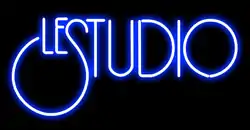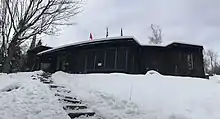Le Studio
Le Studio (later renamed Studio Morin Heights) was a residential recording studio in the Laurentian Mountains near the town of Morin-Heights, Quebec, Canada built in 1972 by recording engineer and producer André Perry, Nick Blagona and Yaël Brandeis. The studio with a Trident console where artists recorded and stayed, was the venue for many notable Canadian and international artists, including Rush (it was nicknamed "Rush's Abbey Road"),[1] The Police, Bee Gees, Chicago, David Bowie, April Wine and Cat Stevens and Vain. Perry described the facility as "like the United Nations. I had people from London, New York, Quebec, all over the world."[2]
 | |
| Address | Morin-Heights, Quebec, Canada |
|---|---|
| Construction | |
| Opened | 1972 |
| Closed | 2003 |
| Demolished | 2020 |
Renowned for its retreat-like location as well as its state-of-the-art equipment,[3] it was one of the earliest studios to install a Solid State Logic SL 4000 B mixing console and RADAR digital-recording equipment.[4] Perry sold the studio in 1988. In 2008 the studio had gone out of business, and as of 2015 the property was up for sale.[5] On 11 August 2017, the building was partially destroyed by "a suspicious" fire.[2] The entirety of the complex was demolished in 2020.[6] In 2020, the recording area was demolished, and in 2021, the entire property was cleared and put up for sale for $850,000.[7]
History
André Perry gained fame as a recording engineer working for John Lennon, and in 1974 was looking to expand his studio, built in a downtown Montreal church. He moved to Morin Heights, where he owned a lake, and built his studio there,[4] with his wife, Yaël Brandeis. The idea was to give recording artists a venue where they could record and live in a creative atmosphere, near the Laurentian Mountains:[1] The Bee Gees, who recorded Children of the World (1976) at Le Studio, stayed for five months.[8] Initially it included a guesthouse about a half-hour's drive away, but it was accidentally burned down by Roy Thomas Baker and Ian Hunter, according to studio designer and engineer Nick Blagona. Later, a house across the lake was acquired and expanded.[8] By the early 1980s it had a reputation as a premier recording venue, after Rush, David Bowie, and April Wine had recorded albums there.[9]
As of December 1980, Le Studio had installed a state-of-the-art computerized Solid State Logic SL 4000 B Master Studio System and expanded to 48-track (created from syncing two 24-track tape machines using video interlock). Other upgrades to the studio included the expansion into video work, with the addition of video post-production and editing facilities.[10][11]
By August 1981, the studio had acquired a JVC BP-90 digital 2-track processor at the choice of André Perry, producer Terry Brown and then-Le Studio staff engineers Paul Northfield and Nick Blagona.[12] It was supposedly first used on a double live LP The Police were mixing at Le Studio that same month,[13][14] although the André Perry website cites their Synchronicity album as being the one.
In 1986 Le Studio issued stock on the Montreal Exchange looking to acquire funding for building a second studio, with audio and video capabilities, in the US state of Washington. 1.1 million shares valued at $3.50 were sold. Perry and Brandeis retained majority interests. They spent $500,000 on a Quantel Mirage digital video effects unit, hoping to install more equipment to allow the recording of sound effects and film music, as well as a Synclavier room.[15]
In 1988 Perry and Brandeis sold the studio,[1] and Perry retired in the early 1990s. The studio, by then called Studio Morin Heights, was acquired in 1993 by L'Equipe Spectra, an entertainment company best known for the Montreal International Jazz Festival which also had a number of local artists on record. Rush and other bands continued to do their tracking there. The new owners also built a new studio room, called "Far Side", which offered a digital RADAR audio recorder and allowed local bands with modest budgets to benefit from the amenities.[4]
The studio was shut down in March 2003 by Spectra.[1] The 233-acre (0.94 km2) site was listed for sale in July 2007, with an asking price of Can$2.45 million.[16] The property remained for sale until 2009, when the land was purchased with the intent to convert the area to a retreat and spa. However, it remained unoccupied, falling into disrepair and was vandalized many times.[17][18]
A US $2.4 million kickstarter campaign was begun in 2015 to rebuild Le Studio, but only $4,000 was pledged.[2]
On 11 August 2017, the studio's building was partially destroyed by a fire in a suspected case of arson.[19] The residential area of the studio was completely destroyed. The recording area still stood but was severely damaged. Geddy Lee of Rush told the CBC, "it was truly a part of the great Canadian landscape... and literally a home away from home for us. It will always have a special place in our hearts."[20][2] In October 2020, the remaining parts of the building were demolished.[6]
Other international artists to record at Le Studio include Nazareth, The Police, Sting, Cat Stevens, The Bee Gees, Keith Richards, Kim Mitchell and Bryan Adams. In January 1992 Celine Dion recorded "With This Tear", a song written by Prince and produced by Walter Afanasieff for her Celine Dion album. Rush recorded at Le Studio during "the peak and the end" of the Terry Brown era.[1]

Some of the engineering staff included Nick Blagona,[8] Claude Demers, Ed Stasium, Leanne Unger, Frank Opolko, Paul Northfield, Glen Robinson, Robert DiGioia, Paul Milner, Simon Pressey, Jacques Deveau, George Pelekoudis, and W. Le Gallee.
The house and grounds are featured in the music videos of the recording sessions of the Rush songs "Tom Sawyer",[1] "Limelight" and "Vital Signs".[21] The studio is also seen in April Wine's music video for "I Like to Rock." Also, an episode of Popular Mechanics for Kids was taped there, with Elisha Cuthbert demonstrating recording and mixing techniques.[22]
Albums and songs recorded at Le Studio
Console history
Source[28]
- 1974-1980 Trident A Range, the first of its kind, now in use at New Monkey Studio in Van Nuys, California
- 1980-1985 SSL 4000B, Serial No. 11, in use at Tree Sound Studios in Atlanta since 1993[29]
- 1985-2008 SSL 4000G sold off in parts
LeStudio Mobile
First built in 1979, LeStudio Mobile provided recording services for live music and special events. The first truck included a 12-input mixing console and 4-track recording. By 2010, a pair of trucks provided 8 mixing consoles on-board provided a total of 144 microphone inputs and 244 tracks of simultaneous recording permanently installed in a 7.5 foot (2.3 m) wide 5-ton truck.[30][31] It was used to record such live albums as Rush's Exit... Stage Left, The Indspire Awards, Hockey Night in Canada and the Montreal International Jazz Festival.[30] The company covered the Juno Awards for more than 23 years, adding a second truck in 2008.[32]
The final large event handled by LeStudio was the Opening, Closing, and Medal Ceremonies of the 2010 Olympic Games in Vancouver.
Through the years LeStudio Mobile evolved with the industry, focusing first on live recorded albums, then audio for DVD productions before moving more into producing audio for live productions while live music productions for HD television brought new business to Le Studio Mobile around 2010, the remote recording business continued to shrink.[33]
As of 2018, Le Studio Mobile had ceased operation.[34] In 2020, the recording area was demolished, and in 2021, the area was cleared and put up for sale for $850,000.[7]
References
- Mobley, Max (2014). Rush FAQ: All That's Left to Know About Rock's Greatest Power Trio. Backbeat. pp. 259–62. ISBN 9781617136047.
- "Fire destroys legendary Le Studio where Bowie, The Police recorded". CBC News. 11 August 2017. Retrieved 13 August 2017.
- Myers 95-96.
- Verna, Paul (25 February 1995). "Studio Morin Heights Reaches Far: Quebec Facility Embraces Int'l, Local Acts". Billboard. p. 91. Retrieved 4 November 2014.
- Kilkenny, Carmel (9 June 2015). "Le Studio, Morin Heights for sale after years of neglect". Radio Canada International. Retrieved 18 June 2015.
- Dwyer, Greg; Michaels, Bill (14 July 2021). "Iconic 'Le Studio' Where Rush, David Bowie, Chicago, Queensrÿche Recorded Demolished". 97X. Retrieved 13 October 2021.
- "Історія покинутої та забутої студії звукозапису «Bee Gees» 1970-х у лісі — «Le Studio» - ottawa-trend.com". 5 September 2022.
- Peacock, Ted (July 2011). "Interview with Nick Blagona". Journal on the Art of Record Production. 5. ISSN 1754-9892.
- Sharp 69.
- "Studio Track: Quebec Studio's Computerization" (PDF). Billboard. 20 December 1980. p. 78. Retrieved 10 April 2021 – via worldradiohistory.com.
- "New York, N.Y." (PDF). Record World. 10 January 1981. p. 32. Retrieved 10 April 2021 – via worldradiohistory.com.
- "Studio Update" (PDF). Recording Engineer/Producer. August 1981. p. 121. Retrieved 10 April 2021.
- "Studio Track" (PDF). Billboard. 10 October 1981. p. 5 51. Retrieved 10 April 2021 – via worldradiohistory.com.
- "1981-12 Musician - PoliceWiki". www.thepolicewiki.org.
- LaPointe, Kirk (16 August 1986). "Le Studio Issues Stock on Montreal Exchange". Billboard. pp. 72–73. Retrieved 4 November 2014.
- Sale brochure Archived 8 October 2007 at the Wayback Machine The property was still for sale as of November 2008
- Kovac, Adam (14 August 2015). "Le Studio: Legendary Morin Heights recording spot in ruins". Montreal Gazette. Retrieved 15 August 2015.
- "Le Studio: Legendary Morin Heights recording spot in ruins". Montreal Gazette. 14 August 2015. Retrieved 3 September 2018.
- Banerjee, Sidhartha (11 August 2017). "Morin Heights' legendary Le Studio the site of "suspicious" fire". Montreal Gazette. Retrieved 11 August 2017.
- "Remembering Le Studio - Rush React After Fire Destroys Studio". News.cygnus-x1.net. Retrieved 14 December 2017.
- NeilPeart.net - News posting 26 April 2006
- FilmRise (9 February 2014). "Popular Mechanics for Kids Season 1 Ep 22 "Music Production"". CTV. Retrieved 14 May 2023.
- "Canada! Quebec Scene Reflects Rich Diversity". Billboard. 2 October 1976. pp. C8–9, 12, 20. Retrieved 4 November 2014.
- Popoff 79-80.
- Popoff 94.
- Popoff 110-11.
- Trynka 432.
- LeStudio Channel (9 April 2014), LE STUDIO - TEMPLE OF SOUND - Episode One - 1080p, archived from the original on 21 December 2021, retrieved 6 September 2018
- "Studios". treesoundstudios.com. Archived from the original on 16 December 2006.
- "Le Studio Mobile". www.studiomobile.com. Retrieved 3 September 2018.
- Music directory Canada (8th ed.). Toronto: Norris Whitney. 2001. ISBN 0969127286. OCLC 51375980.
- "Le Studio Mobile, Le 30". Mix Magazine. September 2009. Retrieved 3 September 2018.
- Jones, Sarah (February 2010). "Remote Recording | Shifting Gears". Mix Magazine. Archived from the original on 4 September 2014.
- "Le Studio Mobile". www.studiomobile.com. Retrieved 3 September 2018.
Bibliography
- Myers, Paul (2007). Barenaked Ladies: Public Stunts, Private Stories. Simon and Schuster. ISBN 9781416587361.
- Popoff, Martin (2004). Contents Under Pressure: 30 Years of Rush at Home and Away. ECW. p. 80. ISBN 9781550226782.
- Sharp, Keith (2014). Music Express: The Rise, Fall & Resurrection of Canada's Music Magazine. Dundurn. ISBN 9781459721951.
- Trynka, Paul (2011). David Bowie: Starman. Little, Brown. ISBN 9780316134248.